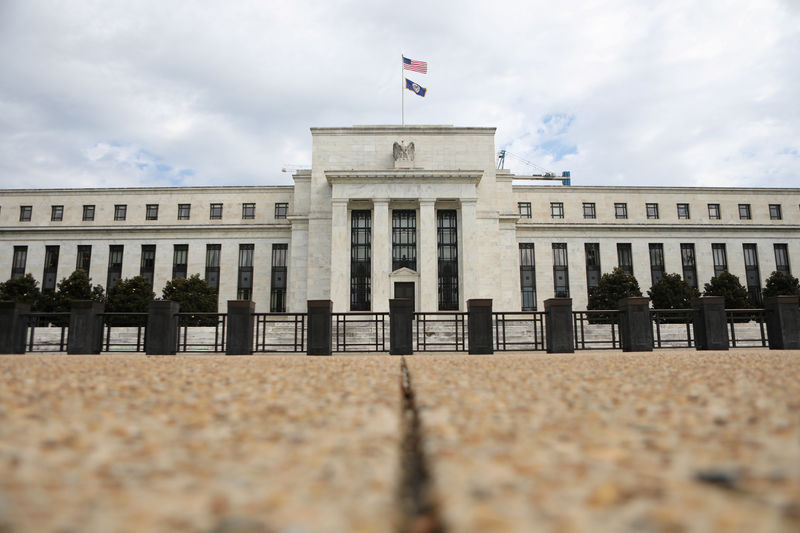(Bloomberg) -- The Federal Reserve is poised to cut interest rates again this week and may still not be done delivering monetary stimulus.
Having already reduced their benchmark in July to 2.0%-2.25%, Chairman Jerome Powell and colleagues will lop off another 25 basis points on Wednesday to support the slowing economy, according to a Bloomberg survey of economists.
Among the key questions that will be asked of Powell is whether he’s preparing for more than the “mid-cycle” adjustment he previously claimed was underway. Economists for now reckon he will act again this year before leaving the target range at 1.5%-1.75% for an extended period.
Also worth watching is how many policy makers will dissent after regional Fed presidents Eric Rosengren and Esther George voted in July in favor of keeping rates on hold, dealing Powell his the first double dissent since he took the Fed’s helm in February 2018.
What Bloomberg’s Economists Say
“Bloomberg Economics expects policy makers to cut rates in steady 25-bp increments until the yield curve is no longer inverted. We believe this means rate cuts in September, October and December -- although officials may hesitate to fully telegraph such intentions just yet, particularly as trade negotiations are underway.”--Carl Riccadonna, Yelena Shulyatyeva, Andrew Husby and Eliza WingerClick here for the full note.
Meantime, the Fed will be followed Thursday by the Bank of Japan as it comes under pressure from investors to follow its U.S. and euro-area counterparts in loosening monetary policy anew. Also meeting next week are the central banks of Brazil, South Africa, Norway, Switzerland and the U.K.
Another big focus for investors will be the U.S-China trade war after last week’s scoop from Bloomberg that Trump administration officials had discussed offering China a limited trade agreement that would delay and even roll back some U.S. tariffs.
Here’s our weekly wrap of what’s going on in the world economy.
U.S. and Canada
The Fed officials start meeting on Tuesday before issuing their decision on Wednesday with Powell addressing reporters afterward. As they gather, they’ll have new industrial production data for August, with economists predicting a 0.2% gain.
With talks with China set to restart in October, there will be monitoring of Twitter and local Chinese media for signs relations between the two sides are improving. There’s also housing starts numbers on Wednesday morning and jobless claims on Thursday. Thursday will also see the release of current account data for the second quarter. It will be monitored for signs of a fallout from the U.S.-China trade war. In Canada, the election campaign will enter a second week.
- For more, read Bloomberg Economics’ full Week Ahead for the U.S.
The Bank of Japan meets on Thursday although pressure from markets to add to its stimulus has weakened as investors take a less gloomy view of the economic outlook and the trade war. That leaves most economists expecting the BOJ to keep policy on hold as it conserves its ammunition. Still, a surprise Fed decision or concerns over the economic hit of a looming sales tax hike could still prompt the central bank to act.
Meantime, Monday includes a rush of data from China will indicate how its already slowing economy is faring amid the trade war. Bloomberg Economics reckons industrial production will remain under pressure after slumping to a 17-year low of 4.8% in July, while there are few signs retail sales picked up in August either. Fixed asset investment is also seen staying sluggish. Pakistan is set to keep interest rates on hold on Monday. On Tuesday, the Reserve Bank of Australia releases minutes of its latest meeting at which it signaled its in no hurry to ease policy again. Indonesia’s central bank is expected to take a pause after two back to back rate cuts.
- For more, read Bloomberg Economics’ full Week Ahead for Asia.
The week may feature aftershocks from the European Central Bank’s stimulus package, with euro-zone policy makers due to speak in numbers after some pushed back against President Mario Draghi’s bond-buying program. Governments will also be quizzed as to whether they plan to heed Draghi’s call for help.
The Swiss National Bank will also decide on Thursday whether to follow its bigger neighbor with a cut in its own rate, already the world’s lowest. Norway’s central bank, meanwhile, may buck the global trend with an increase in its benchmark on the same day. The final Bank of England decision before the currently scheduled date of Brexit provides an opportunity for Governor Mark Carney and colleagues to hone expectations if they so desire. Data-wise, Germany’s ZEW index on Tuesday will provide more clues on whether Germany has avoided a technical recession.
Ghana and South Africa may hold off on joining the global monetary-policy easing wave when their central banks meet on Thursday and Friday, after having each cut once this year.
- For more, read Bloomberg Economics’ full Week Ahead for EMEA
In a week with few economic indicators, Brazil’s central bank is set to grab investors’ attention. While policy makers are expected to cut the benchmark Selic interest rate by another half a percentage point to an all-time low on Wednesday, policy makers’ post-meeting statement is expected to offer clues about how much lower borrowing costs can go. On Thursday, Argentina is set to release unemployment data for the second quarter, which may show the job market was already deteriorating even before local markets started to sell off.
Argentina Still in Recession
- For more, read Bloomberg Economics’ full Week Ahead for Latin America
